
The melting of Antarctic sea ice may be even worse than we realized.
New research suggests that the region is experiencing rapid and abrupt disruptions that could represent a global climate “tipping point,” past which the effects of climate change become irreversible and accelerate in intensity.
“Antarctica is showing worrying signs of rapid change across its ice, ocean and ecosystems,” Nerile Abram, a professor at the Australian National University and lead author of a new study published in the journal Nature, told Agence France-Presse. “Some of these abrupt changes will be difficult to stop.”
Using ice core samples and satellite observations, the team documented a worrying “regime shift” taking hold in Antarctica in which the extent of the region’s sea ice — free-floating icebergs, as opposed to features like ice shelves, which are fixed to land — has dropped below a point lower than anything seen in past centuries. Even more worrying is the rapidity of the shift: this historic low is following a high peak of expansion. In numbers, the authors say that sea ice has retreated from the continent’s shoreline by roughly 75 miles on average since 2014, per AFP.
The ice melt directly contributes to rising sea levels, but that’s only one part of the problem. Ice sheets reflect a significant amount of sunlight, and once they shrink or disappear, more solar radiation gets trapped in the ocean, contributing to warming (not to mention endangering marine life). That creates a deadly feedback loop: more warming means more melting, and the cycle goes on, threatening to snowball out of control.
This has to be avoided at all costs, the scientists say.
“Once we start losing Antarctic sea ice, we set in train this self-perpetuating process,” Abram told Reuters. “Even if we stabilize the climate, we are committed to still losing Antarctic sea ice over many centuries to come.”
That warming would also imperil other frozen bodies, like the Thwaites, or “Doomsday,” glacier, which could singlehandedly raise global sea levels by over two feet if it melts. Already an ominous threat, in recent years scientists have discovered that the glacier is even more vulnerable to melting than once thought, after revealing that its underbelly, long assumed to be protected from warming by hugging the sea floor, actually experiences intrusions of warm saltwater when being lifted by high tides. In light of that revelation, the International Thwaites Glacier Collaboration estimates that the Thwaites could completely collapse within 200 years.
The authors of the new paper also suspect that the melting sea ice will accelerate the collapse of the Antarctic Overturning Circulation, a crucial system that moves warm waters around the planet while spreading nutrients, the fate of which is entangled with the survival of countless marine habitats. A previous study predicted that the globe-spanning current could slow to less than half its speed by 2050 if we don’t stop burning fossil fuels.
As an absolute bare minimum, we need to continue reducing our emissions, the authors say, in order to keep ourselves from exceeding 1.5 degrees Celsius of warming. But we‘re already past the point where we can guarantee that doing so will help undo the damage.
“The tipping point for unstoppable ice loss from the West Antarctic Ice Sheet could be exceeded even under best-case CO2 emission reduction pathways, potentially initiating global tipping cascades,” they wrote.
More on climate change: Scientists Find Evidence That You’re a Hypocrite Who’s Causing More Than Your Share of Climate Change